The greenland halibut
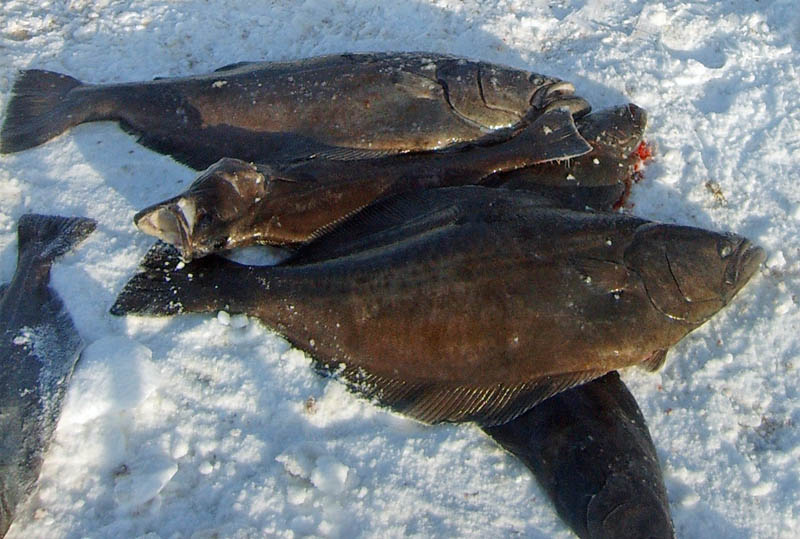
The halibut (Reinhardtius hippoglossoides) is a flatfish belonging to the family Pleuronectidae (“right-handed flounder”), which also includes the halibut. The Greenland halibut is often confused with the Atlantic halibut, but the Greenland halibut is a solid-coloured brown grey on the upper side and varying from light blue-grey to brown-grey on the underside, where the Atlantic halibut is olive green on the top and white.
Age
Males and females of halibut grow equally fast, but females grow up to 25 years old (max. 125 cm), while males rarely stay more than 11 years (max. 80 cm). You determine the age of a fish by counting the year rings (= the depositions) in the fish’s otolith, but halibut grows slowly, and the rings in the otolith therefore lie close, which makes them difficult to count. At the same time, the otolith is very irregular and has many secondary rings (depositions that do not mark a year). It is therefore difficult to count the annual rings of Greenland halibut that are more than 10-15 years old.
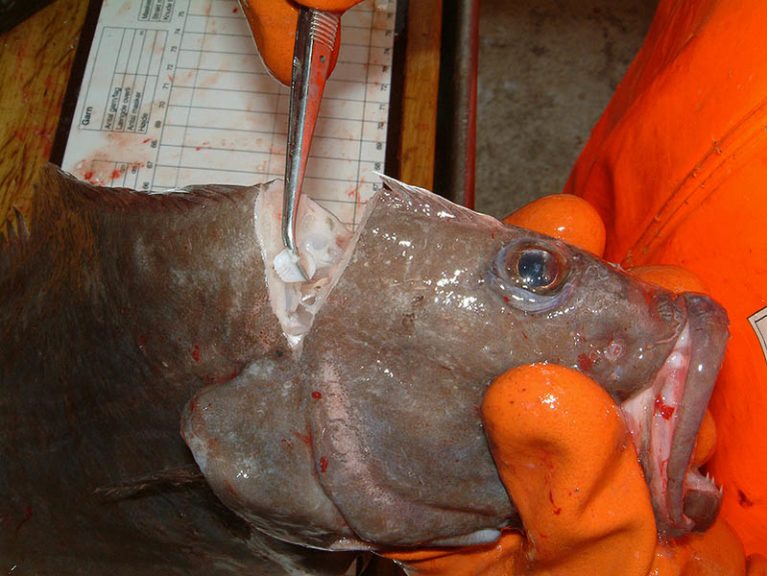
The biologists take the otolith out of the halibut
Reproduction
Halibut females become mature when they are approx. 10 years old (≈ 60 cm). Males are already mature at the age of approx. 7 years (≈ 50 cm). The matured halibut searches for spring from the Davis Strait – and probably also from the Baffin Bay – down towards the spawning area in the central part of the Davis Strait off Nuuk, where the eggs are spewed on more than 1000 m deep water. The largest females can spawn up to 280,000 eggs. Halibut that has grown up in the fjords is not believed to swim back to the Davis Strait to spawn. Because of the low temperatures in the fjords (1-2 ° C), they also cannot finish developing eggs and sperm and therefore rarely spawn.
The eggs are approx. 4 mm in diameter and hatched after 50-60 days of development. The 10-12 mm halibut larvae stay from May to the end of August in the upper 50 meters of the water column, where they drift with the flow as they grow. The first many weeks the larva lives of the gestational sack from the egg; then they start to eat plankton.
The larva resembles an “ordinary” fish with one eye on each side of the head, but as the larva grows and becomes flat, one eye gradually migrates on the backside (the process stops earlier than in other flatfish, and the adult halibut therefore has one eye in the forehead). When the larva is approx. 8 cm long and has the shape of an adult halibut, it seeks towards the bottom (“settler”) of 300-400 m of water. It happens in September-October. Store Hellefisk Banke (SV for Disko) and Disko Bay are important “settling” areas, but some larvae probably also end up further north along Disko and in Baffin Bay.
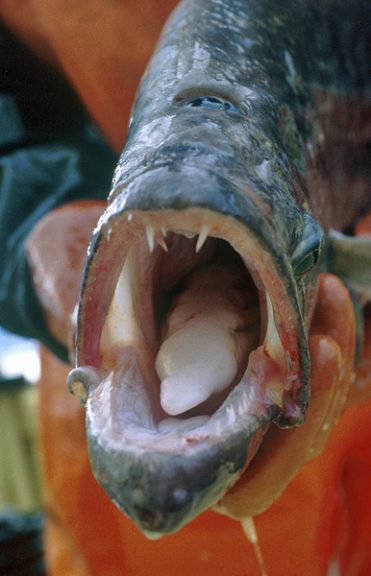
Halibut seen from the front. One eye is in the “forehead”
Food
Halibut larvae live on microscopic zooplankton (water fleas, shrimp and fish larvae), which they find in the upper water layers. The adult Greenland halibut is a predatory fish that mostly stays at the bottom, where it takes fish, shrimp and octopus, but it also sometimes swims in the water column in search of food such as cuttlefish and polar cod.
The halibut is also a prey
The halibut is an important prey for whales, seals and man. The narwhal preferably eats halibut in the size of 40-50 cm and has a significant influence on the number of halibut and their length distribution. It is estimated that narwhales eat approx. 65,000 tonnes of halibut in the wintering areas of the Baffin Bay. In comparison, a total of approx. 12,500 tons of halibut annually in the outer shore area of the entire Baffin Bay. Other whales like the sperm whale also eat halibut, but we have no knowledge of the number of sperm whales at West Greenland or the proportion of halibut in the sperm whale’s food.
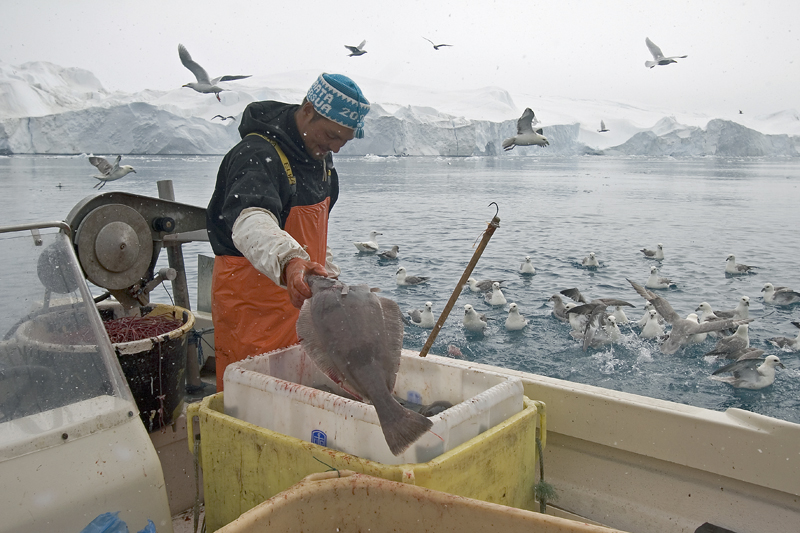
Fishing with longline at Ilulissat
The hooded seal is able to dive deeper than 1,000 m and eats halibut. Very rough calculations have shown that the approx. 100,000 hooded seals located at southwest Greenland (Cape Farewell – Disco) in November-June, eat approx. 60,000 tons of redfish and halibut. They mostly take Greenland halibut, as Atlantic redfish are not so numerous in the area.
People also fish halibut. There are approx. 30,000 tons of Greenland halibut in the West Greenlandic fishing zone. In addition, some small halibut were previously caught as by-catch in the shrimp fishery, but since it is now compulsory to have a grate that conducts smaller fish out of the trawl, the by-catch of small halibut has fallen significantly.
Research on halibut
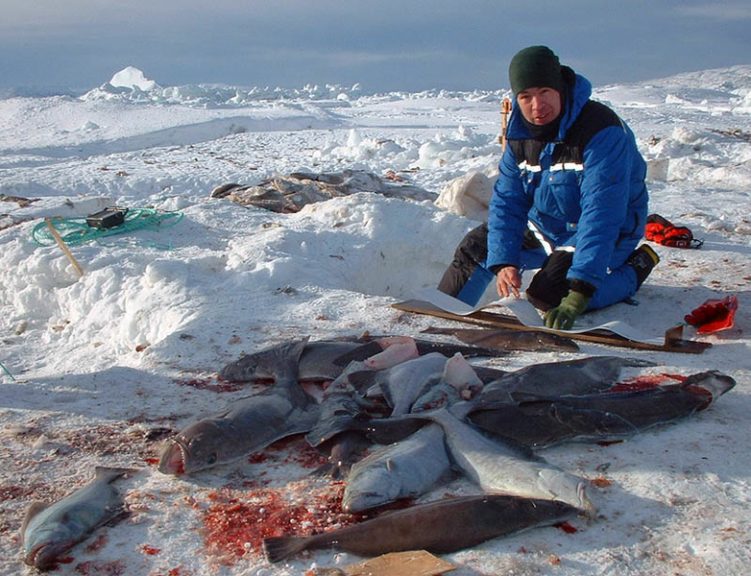
Measuring halibut in Uummannaq.
Since 1985, the Greenland Natural Institute has conducted annual surveys with long-line of Greenland halibut in the fjords of North-West Greenland. Today, the Greenland Institute of Natural Resources is conducting several different types of studies on the stocks of both West Greenland and East Greenland.
Inshore studies
In order to research how the fisheries will develop in the future, the Institute has initiated research with gill-nets, where fishing is carried out with different mesh sizes in the nets. The yarn surveys make it possible to see if there are particularly good stocks on the way into the fishery, and one can follow how the individual stocks develop. This type of study has now replaced the longline fishing studies in Disko Bay.
Every year, from mid-July to the end of August, the stocks of Greenland halibut around Ilulissat, Uummannaq, are examined. The halibut that are caught are measured and gets a small mark with number “shot” under the dorsal fin. Catch, date, length of the fish and the tag number are noted and the fish is released again. Almost all the fish survive the labeling. Some of the trapped fish are also gendered, and they judge their sexual maturity and examine their otoliths for age.
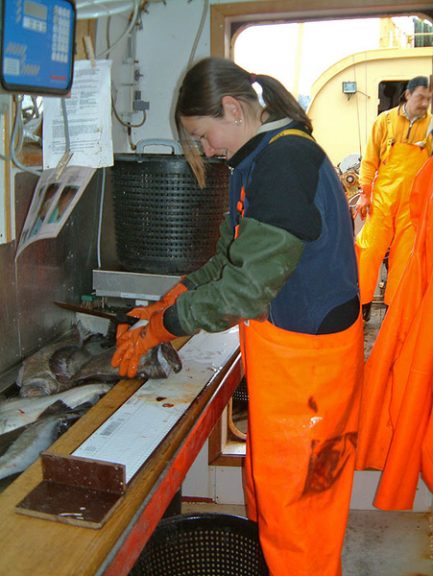
Surveying halibut on board the institutes exploration vessel R / V Sanna.
External studies
In the period 1987-1995, the Japanese exploration vessel Shinkai Maru researched the outermost stocks of Greenland halibut at both East and West Greenland. These annual studies were resumed in 1997 with the Greenland Nature Institute’s trawler R / V Pâmiut. The surveys took in total approx. 5 weeks and takes place with trawls in the Davis Strait and the Danish Strait at depths between 400 and 1,500 meters. In recent years, the Greenland Institute of Natural Resources has also begun to label Greenland halibut on board.
The catch of 1-year-old halibut in the institute’s trawl studies for shrimp is used to assess whether there are good stocks on the way, and whether there is sufficient mature fish to produce good stocks.
The distribution
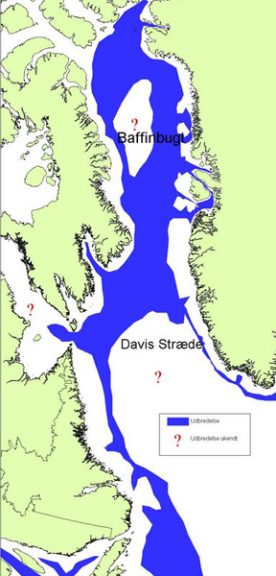
The halibut’s distribution in Baffin Bay
The halibut lives on depths from 200 m to more than 2000 m, in a belt all the way around the North Pole. They live in the waters around Greenland, Iceland and the Faroe Islands, as well as in the Barents Sea and the North Pacific.
In Greenland, the Greenland halibut is widely spread out in deep water, both inshore and offshore from Ittoqqortoormiit south of Cape Farewell up to and probably even further north than Avanersuaq / Qaanaaq in West Greenland.

Map A shows the halibut migrates by Greenland. Map B indicates the number of reef halibut with an indication of the location of the mark
Traits and migration
Over the past hundred years, biologists have labelled halibut to get information about the fish’s migrations and about the fishing pressure. The vast majority of Greenland halibut, which are tagged in the northwest Greenland fjords, are caught in the area where they were labelled. Almost none of the fish that are labelled indigenous in North-West Greenland has been caught in the open. The fish labelled in other areas can, however, travel a long way: The halibut marked in the Davis Strait and in the south-western Greenland fjords, for example wander to Iceland.
With new electronic brands, you can continuously measure the temperature around the fish and the depth it swims in. This way you can gain important new knowledge about which depths and temperatures, the halibut prefers.

The figure at the bottom shows how a fish has moved up and down the water at East Greenland in the period 12th-20th. September 2008. Some days the fish has moved several hundred meters up or down the water in a few hours, while the other days have been less active.

